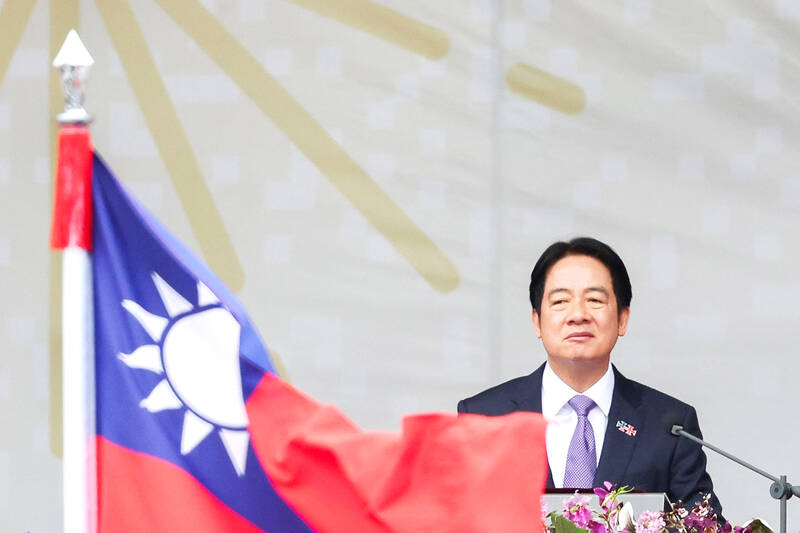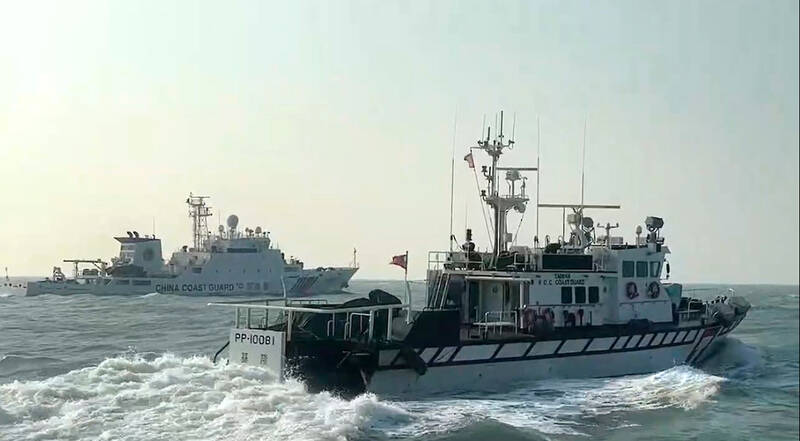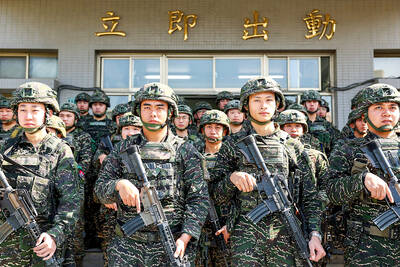In the run-up to World War II, Admiral Wilhelm Canaris, head of Abwehr, Nazi Germany’s military intelligence service, began to fear that Hitler would launch a war Germany could not win. Deeply disappointed by the sell-out of the Munich Agreement in 1938, Canaris conducted several clandestine operations that were aimed at getting the UK to wake up, invest in defense and actively support the nations Hitler planned to invade.
For example, the “Dutch war scare” of January 1939 saw fake intelligence leaked to the British that suggested that Germany was planning to invade the Netherlands in February and acquire airfields it could use to bomb English cities. That scare eventually compelled prime minister Neville Chamberlain to commit to placing troops in France in the event of a German invasion.
Sometimes it almost seems like the People’s Republic of China (PRC) has someone on the inside with the same idea.

Photo: Reuters
PRC AGGRESSION
Last month saw a series of live-fire exercises by the PRC navy that have heightened awareness of its capabilities and aggressive posture. Strangely, it engaged in the exercises off the southeastern coast of Australia, in the Tasman Sea between Australia and New Zealand, on Feb. 21. The PRC did not notify the Australian government, which first learned of it from a Virgin Australia pilot overflying the area. Nearly 50 commercial flights were diverted.
The events alarmed Australia, as they were probably intended to. Yet, if the PRC had simply done nothing near Australia, offered a few concessions to Canberra and played nice, they probably could have gotten the Aussies to turn up sweet. Or at least, remain complacent in the face of the long-term threat. Instead, PRC actions highlighted Australia’s vulnerability to PRC coercion.

Photo: AP
Australian Prime Minister Anthony Albanese was asked by reporters if he would call PRC leader Xi Jinping (習近平) in response to the incident. Albanese told them that they had communicated via each side’s foreign ministers. He described the exercises, held in international waters, as legal. Notably, he made an equivalence between PRC aggression — i.e. live-fire drills — and Australian freedom of navigation operations in the South China Sea, telling the local media that “[The PRC] could have given more notice but Australia has a presence from time to time in the South China Sea [and] this activity took place outside of our exclusive economic zone. Notification did occur.”
This equivalence between PRC aggression and resistance to it, is a common move among PRC apologists. It was shocking to see it on Albanese’s lips. Worse in a way was his insistence that the PRC had notified the Australian government, which forced listeners to choose between the government incompetently not notifying its own people, or Albanese flat-out lying.
Last month also saw two military exercises off Taiwan. The second week of the month, a PRC task force entered the Philippine Sea through the Miyako Strait and operated to the east of Taiwan. The flotilla included an amphibious support ship and an amphibious assault ship, CNS Anhui. It was shadowed by Taiwan navy ships. The Ministry of Defense published a video on X (Twitter) with the caption: “[The PRC’s] aggressive mindset is the greatest threat to the security of the region.”
The second exercise was a live-fire exercise southwest of Kaohsiung, just 75km from the port. Again the defense ministry highlighted PRC aggression: “This move not only poses a high risk to the navigation safety of international flights and ships at sea, but is also a blatant provocation to regional security and stability.”
The Ministry said the exercises were held without notification.
Those exercises were followed on Feb. 26 with a heightened PRC presence, including 45 military aircraft, (34 entering Taiwan’s air defense identification zone, ADIZ), so far the highest number this year, as well as 14 ships, followed by another round of incursions the next day. Amazingly, no US government official was scheduled to visit, a common pretext Beijing gives for military drills.
KMT IRRELEVANCE
Like the needless live-fire exercises off Australia, the exercises off Kaohsiung seemed self-defeating. First, they heightened the PRC threat for the people of Taiwan, who often seem to have successfully compartmentalized it out of existence. Second, as PRC planners surely know, there is a massive recall movement against the PRC-aligned legislators of the Chinese Nationalist Party (KMT), a recall movement that exists in part because the KMT has attacked the defense budget. In the midst of that, the PRC decides to remind Taiwanese that they need defense spending.
It is also a reminder that, for the PRC, the KMT doesn’t matter, except as a particular tool for subverting Taiwan, which should signal the KMT about its fate once Taiwan is occupied. PRC planners know perfectly well that pro-PRC people in Taiwan will serve the PRC no matter how they are treated.
In fact, this military exercise illuminates the PRC’s future plans. If the PRC really seeks a peaceful solution, why is it undermining its allies in Taiwan? Why hold exercises off Kaohsiung just after one of the PRC’s most prominent allies in Taiwan, Hualien Legislator Fu Kun-chi (傅崐萁), returned from a trip to Hong Kong? Unannounced live-fire exercises seem intended, at least in part, to undermine the KMT, to signal its irrelevance. The pro-Taiwan side needs to keep pointing that out.
Yet, a central problem of PRC planners is legitimating war to their citizens, who do not want it. By holding such exercises, seemingly helping the pro-Taiwan side, they can present to their own people a situation in Taiwan that they can describe by saying: “look, we tried everything, but they still opted for their obstinate pro-independence leaders. Because of that, we have to use force.”
Military exercises thus signal that the PRC has chosen war.
Periodic outbreaks of force like this are win-win for the PRC. It wins if Taiwan capitulates to the threat without a fight, and it wins if Taiwan responds by growing more defiant.
TESTING THE US
In both Australia and Taiwan, as with its expansionist pressure on the Philippines and its pressure on Japanese islands, the PRC is above all testing the US.
Last week, US President Donald Trump was asked by reporters whether he would permit the PRC to forcibly annex Taiwan. Trump did not answer the question, unlike his predecessor Joe Biden, who affirmed several times that the US would intervene in the Taiwan scenario — most notably standing next to the prime minister of Japan (hence suggesting there is an agreement of some kind between Tokyo and Washington).
Trump should get credit for this much: he is the first US president ever to truly achieve strategic ambiguity. No one knows what he will do.
Thus, as a friend observed sadly on Twitter, the question becomes whether Trump wants to use this ambiguity as leverage against China — or against Taiwan.
Notes from Central Taiwan is a column written by long-term resident Michael Turton, who provides incisive commentary informed by three decades of living in and writing about his adoptive country. The views expressed here are his own.

That US assistance was a model for Taiwan’s spectacular development success was early recognized by policymakers and analysts. In a report to the US Congress for the fiscal year 1962, former President John F. Kennedy noted Taiwan’s “rapid economic growth,” was “producing a substantial net gain in living.” Kennedy had a stake in Taiwan’s achievements and the US’ official development assistance (ODA) in general: In September 1961, his entreaty to make the 1960s a “decade of development,” and an accompanying proposal for dedicated legislation to this end, had been formalized by congressional passage of the Foreign Assistance Act. Two

President William Lai’s (賴清德) March 13 national security speech marked a turning point. He signaled that the government was finally getting serious about a whole-of-society approach to defending the nation. The presidential office summarized his speech succinctly: “President Lai introduced 17 major strategies to respond to five major national security and united front threats Taiwan now faces: China’s threat to national sovereignty, its threats from infiltration and espionage activities targeting Taiwan’s military, its threats aimed at obscuring the national identity of the people of Taiwan, its threats from united front infiltration into Taiwanese society through cross-strait exchanges, and its threats from

Despite the intense sunshine, we were hardly breaking a sweat as we cruised along the flat, dedicated bike lane, well protected from the heat by a canopy of trees. The electric assist on the bikes likely made a difference, too. Far removed from the bustle and noise of the Taichung traffic, we admired the serene rural scenery, making our way over rivers, alongside rice paddies and through pear orchards. Our route for the day covered two bike paths that connect in Fengyuan District (豐原) and are best done together. The Hou-Feng Bike Path (后豐鐵馬道) runs southward from Houli District (后里) while the

March 31 to April 6 On May 13, 1950, National Taiwan University Hospital otolaryngologist Su You-peng (蘇友鵬) was summoned to the director’s office. He thought someone had complained about him practicing the violin at night, but when he entered the room, he knew something was terribly wrong. He saw several burly men who appeared to be government secret agents, and three other resident doctors: internist Hsu Chiang (許強), dermatologist Hu Pao-chen (胡寶珍) and ophthalmologist Hu Hsin-lin (胡鑫麟). They were handcuffed, herded onto two jeeps and taken to the Secrecy Bureau (保密局) for questioning. Su was still in his doctor’s robes at